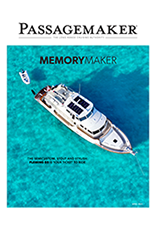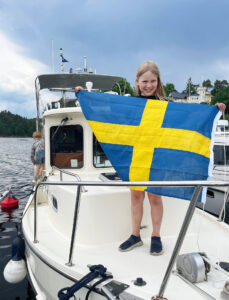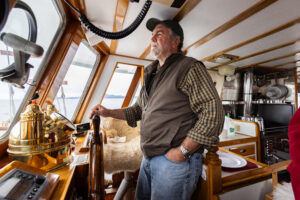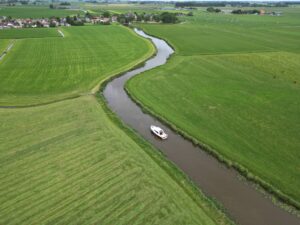Paific white-sided dolphins frolicked and fed all around the 12-foot rib carrying the two California dudes and me across the Bay of All Saints. There must have been a thousand of them-dolphins not saints-and they were so close Gary Johnson couldn’t help but reach into the water beneath our bow wake.
“I never experienced anything like this in my life,” California dude hollered over the outboard, his mullet haircut luffing in the breeze. “To reach down and touch a dolphin-incredible!”
Gary’s sidekick, Russell The Aging Surfer Boy, was happy, too. He had been first to spy the feasting dolphins. Now as he piloted the RIB in circles, dolphins slipped in and out of our bow wake. In every direction, the bay roiled with leaping beasts. They were thick beneath us, too, seeming in the clear green like so many dolphins in aspic.
The only frustrated actor was the photographer. My digital camera has a tenth of a second shutter delay, which meant that even if I pushed the button at the first sign of a gray snout, the best I could hope for was an image of a plunging gray tail.
What the heck, the dolphins were a bonus anyway.
We were on our way back to Ensenada from the Islas de Todos Santos, where we had seen basking sea lions and one of the most dramatic surfing venues on the planet. The islands themselves were like most of the Baja coast, craggy and lunarlike, set (on that particular November day) in a sea of tranquility.
I had met the dudes the night before at Hussong’s Cantina, a world-famous dive, where gringos and educated young Mexicans gather for beer, fellowship and mariachi. A German prospector named John Hussong founded the place in 1892, and the city of Ensenada sort of grew up around it. In the 1930s, it became a Hollywood haunt for the likes of Gable and Lombard. It’s got verisimilitude right down to the termite damage. That’s because Hussong’s slick merchandising wing is in a big storefront across Avenida Ruiz, which provides a churchand- state-like separation.
Johnson keeps his sturdy Neptunis motoryacht in Ensenada part of each year, but the reason makes him an exception. Johnson comes for the fishing, but he also enjoys Ensenada’s vibrant nightlife. Sooner or later any serious West Coast passagemaker will spend some time in Ensenada-and for good cause- but Baja California’s leading seaport is not widely considered a cruising destination in and of itself.
To me this seems a bit of a mystery. Ensenada is an honest city with excellent marinas, decent restaurants and interesting shopping opportunities; it’s also a good staging area from which to explore the peninsula by land. Here I admit my East Coast ignorance, but I would have thought that with such a dearth of harbors in Southern California, Ensenada would be an obvious alternative to Catalina Island. East Coast destinations are varied and plentiful, but despite our embarrassment of riches, if Ensenada were magically relocated to our side of the continental divide, we would surely place it on a par with Portland, Maine, Charleston or Key West.
As it now stands, Ensenada’s role has been to serve as Mexico’s port-of-entry en route to the Sea of Cortez or the Panama Canal. It’s also a great place for repairs, thanks to Baja Naval boatyard, and a haven for California mariners avoiding the taxman.
Say you don’t want to pay nearly 8 percent of the purchase price of that new Fleming 55 to the state of California in sales tax. Take delivery of the vessel offshore; that is, outside U.S. waters. Then steam to Ensenada and put your boat in a marina for 90 days of “cruising” in foreign waters, thus fulfilling California’s legal criteria for an exemption. That’s why the city’s high-end marinas are often referred to as “90-day yacht clubs.”
The Mexican government wants to attract more cruising yachts down the 750-mile Pacific Coast of the Baja Peninsula and up into the Sea of Cortez as part of its Escalera Nautica (Nautical Ladder) program. This ambitious undertaking calls for development of marinas with basic facilities-the rungs of the ladder- every 120 miles down the coast. Making this rugged coast more accessible will surely accelerate Ensenada’s growth as a recreational boating center.
The recession and some planning hurdles have postponed the project, not to mention opposition by environmentalists, but the government is expected to enact some no-cost rule changes to make cruising Mexican waters less intimidating.
Regulations for cruising Mexican waters, like those of many Latin American nations, predate recreational boating. In other words, the rules are designed for commercial shippers, not cruisers, which means having to complete paperwork with officials at every anchorage as if you were carrying a cargo of scrap metal. At the urging of tourism officials, Mexico is considering a system to allow boaters to purchase cruising permits valid throughout Mexican waters, much like the Bahamas does.
My source for this is Tomas Fernandez, whose family owns the Baja Naval boatyard. Finding a boatyard owner who also is an environmentalist is rare anywhere. Finding him in Mexico is stereotype-shattering. He’s working with government and business to make Ensenada the first “ecological port” in Mexico by adherence to international standards of the ISO. Measures would include setting oil booms during the refueling of the fishing fleet to prevent diesel skim on the water and catching toxic paint dust when sanding boat bottoms.
Fernandez, who was educated in the United States, said he believes the key to opening Mexican waters up to Yankee cruisers is to reduce culture clash as much as possible and make the American boating public feel more comfortable. “It’s about making people feel safe,” he said. That means clean, modern facilities and security. Streamlining the regulations also plays into this because to do so will minimize face time with Mexican officialdom, which can be stressful because of the language barrier.
Fernandez, 32, also asked the government to scale back its somewhat grandiose plans for marina development; he said some anchorages really only need a seasonal fuel barge to satisfy passagemakers’ needs, rather than a full-blown marina complex. He said he hopes a proportionate, less-intrusive approach will appease those who fear an influx of cruising vessels will somehow degrade Baja’s marine environment.
“But if it happens to be a place where people will spend some time with their boats, then go ahead and develop it,” he said.
Part of the problem, Fernandez said, is that few Mexicans are coastal cruisers, so there is a disconnect between government planners and the intended consumers, who are primarily North Americans. If you have any suggestions for improving marine infrastructure along the Baja coast, feel free to email them to Fernandez ( [email protected]This e-mail address is being protected from spambots. You need JavaScript enabled to view it ), and he will forward them to tourism authorities in Mexico City.
Fernandez said he is particularly pleased with the city of Ensenada’s new mile-long boardwalk, which passes by Baja Naval’s boatyard and marina. “This is the nicest kept area in Ensenada,” he said. “There are no beggars, no people trying to sell you stuff.” The centerpiece is a Mexican flag the size of Kansas flying over the harbor.
During my stay, Mexico’s soccer team had just whipped Honduras, and an impromptu hornhonking motorcade discharged its celebrants to rally around that great flag. Just down the boardwalk, families bought baitfish and tossed it to the harbor’s tame seals.
Truth be told, I have seen few beggars anywhere in Ensenada over the years. For beggars stay in San Diego, where they are called “homeless.” Sure, many people in Ensenada will try to sell you things, some of which you might actually want to buy, but a polite “no” is all it takes to dissuade them.
Many stores, restaurants and attractions are a short, safe walk from the central waterfront, and to me the city feels as comfortable as an old sweater.
Approaches
(Isla de Todos Santos, Northwest light at 31°48.75N, 116°48.7W. Ensenada Harbor Entrance at 31°50.23N, 116°37.59W) Ensenada is an easy 60-nautical mile trip from San Diego. Pass inside the Coronado Islands, staying 5 to 8 miles from the mainland. There are no outlying hazards. Following the coast will take you on a southwesterly course into the box-shaped Bay of All Saints with San Miguel Point to port and Islas de Todos Santos to starboard.
Ensenada’s most prominent features from seaward are the pinkish high-rise hotel Villa Marina and two red container cranes on the seaport’s west jetty. Marina Coral, with its own riprap breakwaters, is 2.75 miles north of the seaport. The rest of the marinas are inside the jetties that form the municipal harbor. A light marks the bigger of the two, the west jetty. Juanito’s, Sergios and Baja Naval marinas are in the northwest corner of the harbor, while one of the newest is behind the cruise ship dock. Follow the marked shipping channel into the anchorage avoiding shallows in front of the giant Mexican flag.
A word of warning: Shiny new Mexican patrol boats prowl the waters off Ensenada looking for contraband-people and drugs heading north, guns south. If they stop you en route to Ensenada, they suspect guns. The possibility of a boarding by seagoing federales is strong incentive to make this leg in daylight unless your VHF Spanish is good enough to avoid misunderstandings.
Chart: DMA Point Loma to Point Eugenia, Waterproof Chart No. 83, reproduces DMA 18766, 21004, 21021, 21140 and 21160 with insets for San Diego Bay and Ensenada.
Cruising Guide: Baja Boater’s Guide: Volume I, The Pacific Coast by Jack Williams, includes black and white aerial photos and sketch charts.
For The Boat
Marinas: Ensenada has five good marinas in varied locations for a total of nearly 600 slips. Three are on the central waterfront; one is in the cruise ship complex; and the other at a resort on the outskirts of the city. As part of their service, marina personnel will help handle your Mexican entry requirements, though some charge a modest fee.
Marina Coral (800.862.9020; fax 011.526.175.0005; www.hotelcoral.com). Transient dockage is $1 a foot for vessels up to 65 feet, though larger boats can be accommodated. Rates include electricity and use of Coral Hotel facilities (spa, fitness center, pool and tennis courts). Telephone and cable television also are available. This “90-day yacht club” boasts 370 slips in a luxurious resort setting. Despite the protection of overlapping riprap jetties, a surge does manage to snake its way into the marina, but it is not severe. Diesel fuel is available by truck or barrel. Monitors VHF Channel 71.
Marina at Ensenada Cruiseport Village (011.526.173.4141) Short-term rates are $1 a foot. This brand new facility has 189 slips and a face dock big enough for several megayachts. The marina is surrounded by a rectangular mole occupied by shops and restaurants for cruiseship tourists. The ships tie up to the outside of the mole. Security is excellent. Downtown is a half-mile away. Monitors Channel 16.
Baja Naval (011.526.174.0020; fax 011.526.174.0028; www.bajanaval.com). Shortterm dockage depends on length. For example, $22.50 per day for boats 36 to 50 feet, and $26.50 per day for vessels 51 to 60 feet. It is planning to expand to about 100 full-service slips in the near future. Fuel is available by truck or barrel. This marina would be my first choice because it combines quality facilities with unbeatable convenience to the city, just two minutes away on foot. Next door are Juanito’s Sportfishing Docks and Sergio’s Marina, which have some guest slips. Juanito’s operates a fuel barge.
Anchorages and Moorings: Speak to the port captain about anchoring. He will direct you to the northeast section of the basin, where the depth ranges from 12 to 18 feet; there is a modest fee. Baja Naval marina has a dinghy dock for cruisers. For moorings or a water taxi, hail one of the marinas on Channel 14 or 16.
There also is a protected anchorage on southernmost Islas de Todo Santos. There are three coves on the eastern side of the island, anchor in the center cove. Watch your weather. If the wind comes strong from the east, this idyllic spot turns into a death trap.
Hauling and Repairs: The aforementioned Baja Naval is a splendid 120,000-square-foot facility, capable of working on vessels of up to 75 feet. When I mentioned that I was going to Ensenada, the boaters I had spent time with in San Diego didn’t talk about Hussong’s; they talked about the great workmanship and reasonable rates at Baja Naval. When I visited Baja Naval, a dozen projects were under way, including the replanking of an old sailboat and a motoryacht cockpit extension. The yard also specializes in paint jobs, hard tops, bait tanks, interior cabinetry, Mig and Tig welding, deck refits and thruster installations.
Crew Changes: Servicious Turisticos de Baja California, near the waterfront at the corner of Avenida Riveroll and Calle Segunda, provides van service to and from San Diego Airport, starting at $125 for one to three people. It is also an agent for the Hertz Rent-A-Car company. Call 011.526.178.2982.
Things To Do
Shopping: Avenida Lopez Mateos, a couple of blocks from the harbor, awaits the surge of cruise ship tourists four days a week. All manner of native crafts can be purchased here, including jewelry, leather goods, carvings, clothes, blankets and goofy novelties.
I have always been a sucker for the polished ironwood wildlife carvings of dolphins, ducks and elephants. These heavy wooden carvings, made from slow-growth desert trees, come from mainland Mexico and are sold both in shops and by street vendors. My shopping technique is to see what they cost at the shops and then negotiate a better price with a street vendor.
Mexico is known for its fine silver work, and there’s plenty to look at in the shops of Lopez Mateos, but my Mexican friends advise that for big silver purchases go to Sixth Avenue in downtown, where locals buy the same jewelry at lower prices.
Southbound voyagers would be remiss if they didn’t take advantage of Ensenada’s pharmacies to stock their medical kits. As is the case in many developing nations, Mexicans can’t afford a doctor every time they need a prescription, consequently many drugs sold by prescription in the U.S. are over-the-counter in Mexico, including Cipro and Viagra.
Ensenada has a great fishmarket near the boardwalk and downtown marinas. Fresher fish you will not see anywhere, nor at better prices. Even when I’m just driving through Ensenada and staying in hotels I usually walk through and imagine how good those inch-thick tuna steaks would be grilling in the cockpit.
Sights and Tours: America’s growing love for wine is a trend not lost on Baja’s winemakers, which have responded with some decent bottles. About 45 minutes from Ensenada on Route 3, the road to Tecate, are seven wineries that offer tours and tastings. I spent a pleasant couple of hours last fall at the L.A. Cetto Winery (011.526.155.2264). Others include Monte Xanic (011.526.174.7055) and Casa Pedro Domecq (011.526.155.2249).
Hire a cab to take you up there for a tour and tasting. If you go with another couple, you can split the fare (which shouldn’t be more than $45 for the entire afternoon) and fill the trunk with enough Cabernets and Chardonnays to get you through the Panama Canal.
On an ocean cliffside 45 minutes south of Ensenada is a phenomenon known as La Bufadora or blowhole. As waves hit, seawater is driven up a long hole in the cliff that opens upward spewing a great plume of water and foam. Gringos are often disappointed by the geyser effect, particularly if they visit when the sea is calm, but area Mexicans love La Bufadora because even when the blowhole itself is tame, the assembly of garish shops and snackeries built up around it create a party atmosphere.
I would argue that Ensenada’s safe marinas are ideal staging areas for a rental-car road trip down the peninsula, particularly if the vessel is being hauled for some work.
I have gone as far as Bay of the Angels on the Sea of Cortez side, and I could write another thousand words about that four-day trip if I had room. Suffice it to say, you will never forget the panorama that unfolds when you cross the ridge and look down on that wine-dark bay for the first time. If you are lucky enough to find any fellow cruisers at anchor at the village, they are sure to have knowledge that could ease your passage should you decide to follow in their wakes.
From January to March, California gray whales migrate down the Baja coast to their southern breeding grounds. These 48-foot beasts pass so close to Ensenada to feed in the bay’s nutrientrich waters that they once were hunted here from dories. Nowadays motorists watch them as they drive down the coastal highway from San Diego. If you don’t want to take your own boat whale watching, hitch a ride on one of the local sportfish boats, many of which are dedicated to whale watching during winter.
Restaurants
The rape of Mexico by 16th-century Spain may have been the sum of 100,000 atrocities, but it also spawned some great food. Baja is uniquely endowed by geography to interpret Mexico’s hybrid culinary heritage by virtue of cattle ranching, farming and fishing in close proximity- surf, turf and tomatoes. Here, there is no excuse for anything but the freshest ingredients.
Ensenada has some good restaurants, a few of which I will mention, but it is famous for the fish tacos sold by street vendors. The fish is lightly battered and deep fried, then garnished with your choice of fixings in a corn or wheat tortilla for a glorious lunch or afternoon snack! Another treat for the adventurous is the seafood cocktails of raw fish, oysters and the like, marinated in lime juice and served in spicy sauce.
My favorite: Some coastal places in Baja serve steamed clams topped with fresh cilantro and surrounded by native sliced limes, drawn butter and a rack of different hot sauces. Twenty clams for four bucks, as I recall.
La Embotelladora Vieja. (The Old Bottling Room) This restaurant, as the name suggests, is in the former bottling room of the adjacent St. Tomas winery. The clientele tends to be upscale and on the Bohemian side. The food is Mediterranean with a Mexican flair.
Casamar on Lazaro Cardenas Boulevard, the divided street near and parallel the waterfront, specializes in Spanish-style seafood, including lobster.
Antares. This is the house restaurant at the Hotel Coral and Marina, and it’s a good one, offering both Mexican and North American dishes, as well as a superb lunch buffet. Try the shrimp cocktail; it substitutes tangy cilantro salsa for cocktail sauce.
Luck Of Geography
Lucky for us that Ensenada is the first stop for West Coast cruisers heading into Latin American waters. This decent little city is an ideal cushion against culture shock. Many places in Latin America will seem downright scary to first-time . Sometimes places that are safer than our hometowns will seem scary because we don’t understand what we are hearing and seeing. Ensenada is not scary. Lucky for us, Tijuana-a place fit only for Marines on leave-isn’t our first port of call.
Ensenada is a place where you can practice your Spanish on friendly people, while stocking a freezer full of fish and having a bowthruster installed at the local yard. Silly East Coast cruiser that I am, I’d trade Miami for Ensenada any day.











